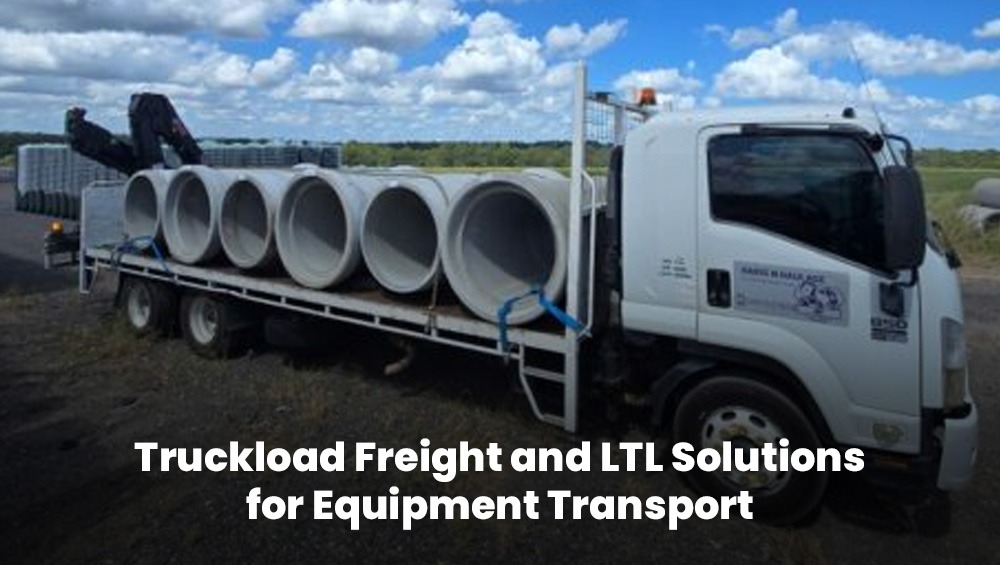Truckload Freight and LTL Solutions for Equipment Transport
Heavy equipment transport is a crucial process in industries such as construction, mining, infrastructure, and large-scale agriculture. Transporting machines like bulldozers, excavators, or cranes isn’t easy. You need to plan for their size, weight, road limits, permits, and safety. Without the right strategy, companies risk delivery delays, equipment damage, and unexpected costs. The key to avoiding these issues lies in selecting the right freight method for each specific load and destination.
Choosing between Truckload and LTL shipping isn’t only about price—it also affects your safety, delivery speed, and future costs. This blog cuts through the marketing jargon and explains both methods from a functional, industrial logistics perspective. We’ll cover what they are and how each method matches the load, schedule, safety rules, and risk—especially for modern equipment transport.
What Is Truckload Freight Shipping?
Truckload freight shipping—often called Full Truckload (FTL)—is a logistics method where a full truck trailer is dedicated to a single customer’s shipment. Unlike LTL, where cargo (equipment being transported) is shared with other shipments, truckload freight is exclusive to your load. It offers direct, door-to-door delivery without terminal stops or freight transfers.
In the context of heavy equipment transport, FTL is typically used when the equipment being transported is too large or heavy to be consolidated with other freight or when the machinery requires secure, uninterrupted transit.
When to Use Truckload Freight Shipping
Truckload freight is the go-to method when:
- The equipment weight exceeds 8 tonnes
- The shipment occupies over half or all of a trailer’s space
- The cargo is oversized, sensitive, or high-value
- You need faster delivery with minimal handling
- The job requires specialized trailers (lowboys, flatbeds, drop-decks)
Example scenarios include:
- Moving a crawler excavator to a new construction site
- Delivering a crane boom that’s too long for enclosed trailers
- Hauling multiple pieces of roadwork machinery across regions
Advantages of Truckload Freight for Heavy Equipment
- Speed & Efficiency
Direct routes without multiple stops or handovers ensure faster delivery. - Lower Risk of Damage
Since your equipment isn’t moved between terminals, there’s minimal handling—ideal for delicate or calibrated machines. - Dedicated Space
Your equipment isn’t competing for room with other freight. This allows for better bracing, tie-downs, and load configuration. - Scalability
Whether you’re moving a single machine or a full site’s worth of gear, FTL adapts to your volume and schedule.
What Is LTL (Less Than Truckload) Freight Shipping?
LTL freight shipping is designed for smaller shipments that don’t require a full truckload. LTL shipping means sharing one trailer with cargo from other shippers. It’s cheaper but can lead to more stops and longer delivery times.
How Does LTL Work in Heavy Equipment Transport?
Though commonly associated with parcels or consumer products, LTL shipping can be applied to heavy equipment transport when dealing with:
- Disassembled machinery
- Small or modular machines
- Tool attachments or parts
- Created engines or hydraulic systems
LTL is often used to supply parts or secondary equipment to a job site rather than transporting entire machines.
Best Use Cases
- Weight between 68 kilograms and 6.8 tonnes.
- Partial machine delivery (e.g., attachments, engine blocks)
- Scheduled non-urgent delivery
- Cost-conscious shipping where direct routing is not a priority
Cost-Saving Benefits
- Pay for Space Used: You don’t have to book an entire trailer.
- Lower Upfront Costs: Ideal for small-scale or frequent equipment deliveries.
- Environmentally Efficient: Combines loads to reduce fuel use and empty miles.
How This Relates to Heavy Equipment Transport
Both FTL and LTL freight shipping are used in the transportation of heavy equipment, but not interchangeably. Here’s why:
- Truckload freight is made for primary machine moves — getting large equipment to or from job sites.
- LTL is ideal for secondary shipments — parts, components, attachments, or modular systems that don’t require their trailer.
Key Differences Between Truckload and LTL
Understanding the nuances between these two freight types helps avoid unnecessary costs or delays. Here’s a side-by-side breakdown:
| Factor | Truckload Freight | LTL Freight |
| Shipment Size | Full trailer (6.8+ tonnes) | Partial trailer (68 kg – 6.8 tonnes) |
| Cost | Higher overall, lower per unit | Lower upfront, shared pricing |
| Delivery Time | Faster (direct route) | Slower (multiple stops) |
| Handling Risk | Low (minimal touchpoints) | Higher (shared space) |
| Use Case | Large or fragile machinery | Smaller equipment or components |
Choosing the wrong shipping method can mean delays, increased costs, or even damaged equipment, so understanding these key differences is vital.
Read More: Gold Coast Cranes
How to Choose the Right Freight Method for Equipment Transport?
Not sure whether to go with truckload or LTL? Here’s how to decide:
1. Assess Load Size and Urgency
- Is your machinery oversized or bulky?
- Does it need to reach the destination by a specific date?
For larger or time-sensitive loads, truckload shipping is often the better choice.
2. Review Project Timeline
- Can your project tolerate a few days’ delay?
- Is your delivery part of a phased rollout?
If time isn’t critical, LTL might be a more affordable option.
3. Evaluate Distance and Route
- Long-distance transport favours truckload for faster delivery.
- LTL is efficient for regional or metro deliveries.
4. Budget Considerations
- LTL saves on cost if your shipment fits within partial capacity.
- Truckload offers better value when volume is high.
5. Equipment Sensitivity
- Fragile or high-value equipment benefits from truckload’s reduced handling.
- Rugged or crate gear can safely travel via LTL.
Why HNH Crane Is a Smart Choice for Equipment Transport
We handle both truckload and LTL shipping for heavy equipment, construction tools, and large industrial items.
Our Core Services:
- Full truckload and less-than-truckload options
- Crane-assisted lifting and secure loading
- Custom logistics planning for oversized machinery
- Local and long-distance freight Crane services
Areas We Serve:
- Ipswich
- Brisbane
- South-East Queensland
- Regional Queensland & beyond
We have years of experience, modern lifting equipment, full freight insurance, and skilled operators who treat your cargo with care.
Whether you’re moving one excavator or several machines across the state, HNH Crane makes sure your equipment arrives safely, on time, and within budget.
FAQ
1. What is the best way to ship heavy, bulky items?
The best way to ship heavy, bulky items is via full truckload (FTL) freight using specialized trailers like flatbeds or lowboys for secure, direct transport.
2. What is LTL freight used for?
LTL freight is used for shipping smaller, palletized loads that don’t require a full truck and are cost-effective when sharing space with other shipments.
3. How is the LTL freight cost calculated?
LTL freight cost is calculated based on shipment weight, dimensions, freight class, distance, delivery speed, and any additional services like lift gate or residential delivery.
LTL Freight Cost = (Base Rate per 100 kg) × (Total Weight ÷ 100) + Accessorial Charges + Fuel Surcharge
4. Is insurance included in truckload shipping?
Basic insurance is usually included in truckload shipping, but full coverage for high-value equipment often requires additional cargo insurance.
5. What is LTL vs truckload?
LTL (Less Than Truckload) is used for smaller shipments that share trailer space with other freight, while Full Truckload (FTL) is for larger shipments that occupy the entire trailer and ship directly without transfers.

